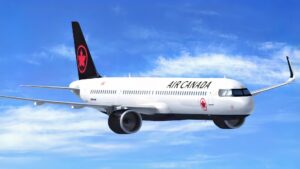
Air Canada is set to enhance its fleet with the addition of the Airbus A321XLR, having placed an order for 30 aircraft, with the first delivery anticipated in early 2026. Originally slated for 2024, the delivery has faced delays. The A321XLR will feature a seating configuration of 182, including 14 fully flat business seats and 168 economy seats. This model will replace the airline’s Boeing 737 MAX 8s for long-haul operations, marking a significant shift in its service capabilities.
In a recent discussion with The Airline Observer, Air Canada’s Chief Commercial Officer, Mark Galardo, shared insights into the operational challenges and potential of the A321XLR. While the aircraft’s range meets expectations, Galardo mentioned several complications that were not fully anticipated at the time of purchase. He highlighted that factors such as short runway lengths and high temperatures can significantly reduce payload capacity, particularly at smaller airports.
He pointed to Madrid as a specific example, noting that Iberia recently announced nine-hour A321XLR flights from Madrid to Toronto next summer. Galardo remarked, “If you’re leaving Madrid at 12 noon in the summer, you’re talking 37 to 38 degrees Celsius. It’s punitive.” This suggests that Iberia may struggle with performance on this route compared to Air Canada’s existing A330-300s and 787-9s.
Potential destinations for Air Canada’s A321XLR include various cities in Spain, such as Bilbao, Ibiza, and Seville. However, Galardo cautioned that the heat could limit operations in these locations during the summer months. Air Canada plans to launch a new route from Montreal to Palma de Mallorca on June 17, utilizing the A321XLR. This raises questions about potential payload restrictions, especially for flights to southern European destinations.
Currently, Air Canada has identified five transatlantic routes for the A321XLR, all departing from Montreal. These routes will connect to Porto, Dublin, Edinburgh, Palma, and Toulouse, averaging 2,876 nautical miles (5,326 km). Notably, Iberia’s A321XLRs are already capable of flying up to 3,920 nautical miles (7,960 km), indicating a difference in operational strategy between the two airlines.
The A321XLR presents a cost-effective option compared to widebody aircraft, requiring fewer passengers to break even on certain routes. This flexibility allows Air Canada to explore new markets and adjust capacity based on demand, potentially increasing frequency or enhancing overall performance.
As Air Canada integrates the A321XLR into its operations, the aircraft will serve various Canadian hubs. The A321XLR is expected to replace the Boeing single-aisle fleet on routes connecting Halifax to Heathrow and possibly on segments between Montreal and Toronto, as well as Keflavik. Future routes may include destinations such as Berlin, Budapest, and Prague, all within the aircraft’s operational range.
In essence, while the A321XLR opens new opportunities for Air Canada, the airline must navigate seasonal challenges, particularly in warmer climates. Galardo’s remarks underscore the importance of strategic planning as the airline prepares for the arrival of this new aircraft type. The A321XLR not only represents a significant investment but also a pivotal shift in Air Canada’s long-haul capabilities, setting the stage for its future growth in international markets.






